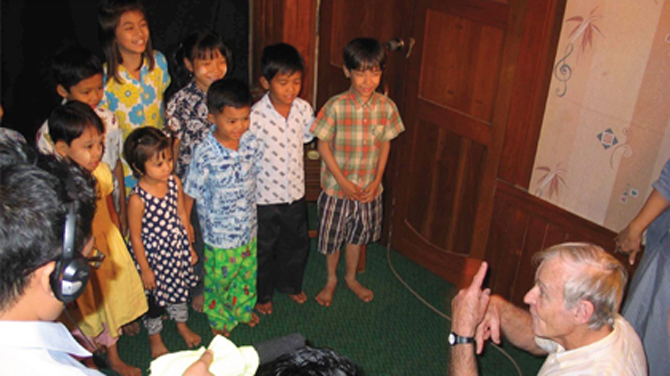Burma Documentary Takes US by Storm

WASHINGTON DC—American professor Robert Lieberman went to Burma to train local filmmakers and shot his own documentary on the sly. The solo-filmed They Call It Myanmar: Lifting the Curtain, pries the lid off daily life in what has long been one of world's most isolated and repressed places, examining its grinding poverty and tragic decades of military rule.
The film is a reminder that, despite recent upbeat news as Burma ventures on a reform path that has seen releases of political prisoners and easing of censorship, it remains a country with huge problems.
The movie is showing at selected theaters in the United States to critical acclaim.
Lieberman, 71, took time off from his regular job teaching physics at Cornell University and traveled to Burma several times over two years, initially on a US government-funded Fulbright program. He helped shoot health awareness commercials, then taught film at a university in the main city Yangon. He also accumulated 120 hours of his own footage, often filmed clandestinely.
Part documentary, part travelogue, They Call It Myanmar absorbs the country's charms and cruelties and spills them out with disarming curiosity. He explains, both from his own perspective and the narrations by anonymous collaborators, just what life is like there and what makes its long-suffering people tick.
In a sense, the film already is outdated. Lieberman did the leg work before change began taking hold, although he sneaked back early last year to interview pro-democracy leader Aung San Suu Kyi after she was released from her latest stretch of house arrest. The Nobel Laureate's musings on the country and its turbulent history are part of the narrative.
Lieberman describes Burma as the second most-isolated country in the world after North Korea, but foreign journalists are now being allowed in to report, and there is public debate on issues such as human rights and ethnic conflict that just a year ago would have been off-limits.
While the isolation and climate of fear has eased, however, that has not translated yet into a shift in political power or improved living conditions. Lieberman's film lays bare how far what was once one of Southeast Asia's most prosperous countries has sunk.
His starting point is not the ruinous military rule that has led it to that point, but, refreshingly, something more simple and vital to Burmese identity: tanaka, a fragrant, light brown paste that people daub on their faces. Opening the movie that way makes sense, as many faces populate Lieberman's film. They are filmed on the street, on trains, in temples, in markets and clinics, though some are blurred out to protect their identities.
The videography is often rough-and-ready but sometimes scenic. He takes in the historical treasures of the country, the famed Shwedagon Pagoda, the hundreds of ancient temples of Bagan, as well as exploring the importance of the predominant Buddhist faith.
He sometimes injects his own dashes of humor, like when he jokes on seeing a Buddha image covered thick with countless offerings of gold leaf: “Shall we grab it and run?”
The abiding theme, however, is deprivation. In one hard-to-watch scene, a young, shaven-headed girl with a deep ulcer cries in pain at an ill-equipped clinic. The doctor says the girl has tuberculosis, but her mother cannot afford the drugs to treat her.
A political prisoner, interviewed off-camera, tells how he was tortured by his jailers who put a bag on his head with two mice inside. He says to stop the mice biting him, he had to bite them back.
In the second half of the film, Lieberman looks at Burma's turbulent modern history. There is rare archive footage of Suu Kyi's father, national hero Aung San, speaking during a visit to Britain before he led the country toward independence after World War II, only to be assassinated months before it shook off its colony status.
The film then tells the compelling story of how Suu Kyi was catapulted to political prominence following a brutal military crackdown on democracy protesters in 1988. The military used deadly force again to put down Buddhist monk-led mass demonstrations in 2007. The junta's reputation was sullied further by its initial refusal to allow in foreign aid after Cyclone Nargis in 2008, which killed 130,000 people.
But what is missing from They Call It Myanmar is what beckons now. Even hardened human rights activists and dissidents view the changes of the past year as the country's most significant in the half-century since the military took power.
The film's touching closing sequences tell of people's aspirations. One Burmese tearfully speaks of how Burma is a proud country, but one that needs help to stand on its own feet. Another simply yearns “to speak, read and write poetry the way your heart tells you to do it.”
- Rangoon on List for Big Weather Disasters
- More Than 100 Orangutans Lost in Indonesian Fires
- North Korea Rocket Could Cause Casualties: US
- Police Bust Asian Human Trafficking Ring
- Vietnam Revokes Visas of Church Officials
- Tibetan Sets Himself on Fire at Anti-China Protest
- Monkey Importer Faces Cruelty Charges Over Thai Shipment
- Authorities Postpone By-elections in Restive North
- Indian Rebels Release One of Two Italian Hostages
- India Lost $210 Billion on Coalfield Sales: Audit
